Behavioral Finance: Exploring Irrational Behaviors of Investors
VerifiedAdded on 2023/06/04
|8
|1598
|485
AI Summary
This paper explores the new behavioral theory that is increasingly being used to explain some irrational behaviors that investors make. It also discusses the importance of behavioral explanation in the financial market.
Contribute Materials
Your contribution can guide someone’s learning journey. Share your
documents today.
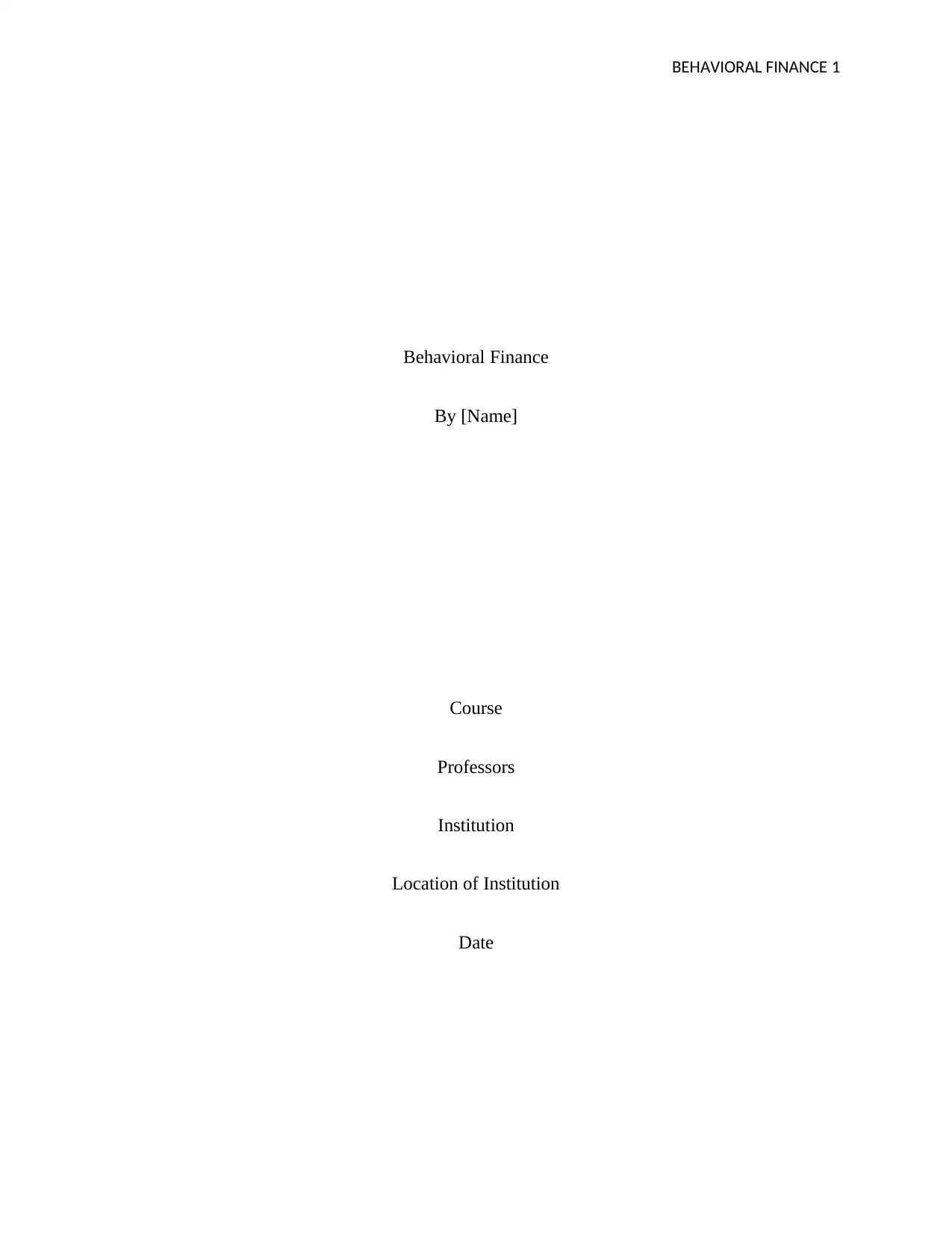
BEHAVIORAL FINANCE 1
Behavioral Finance
By [Name]
Course
Professors
Institution
Location of Institution
Date
Behavioral Finance
By [Name]
Course
Professors
Institution
Location of Institution
Date
Secure Best Marks with AI Grader
Need help grading? Try our AI Grader for instant feedback on your assignments.
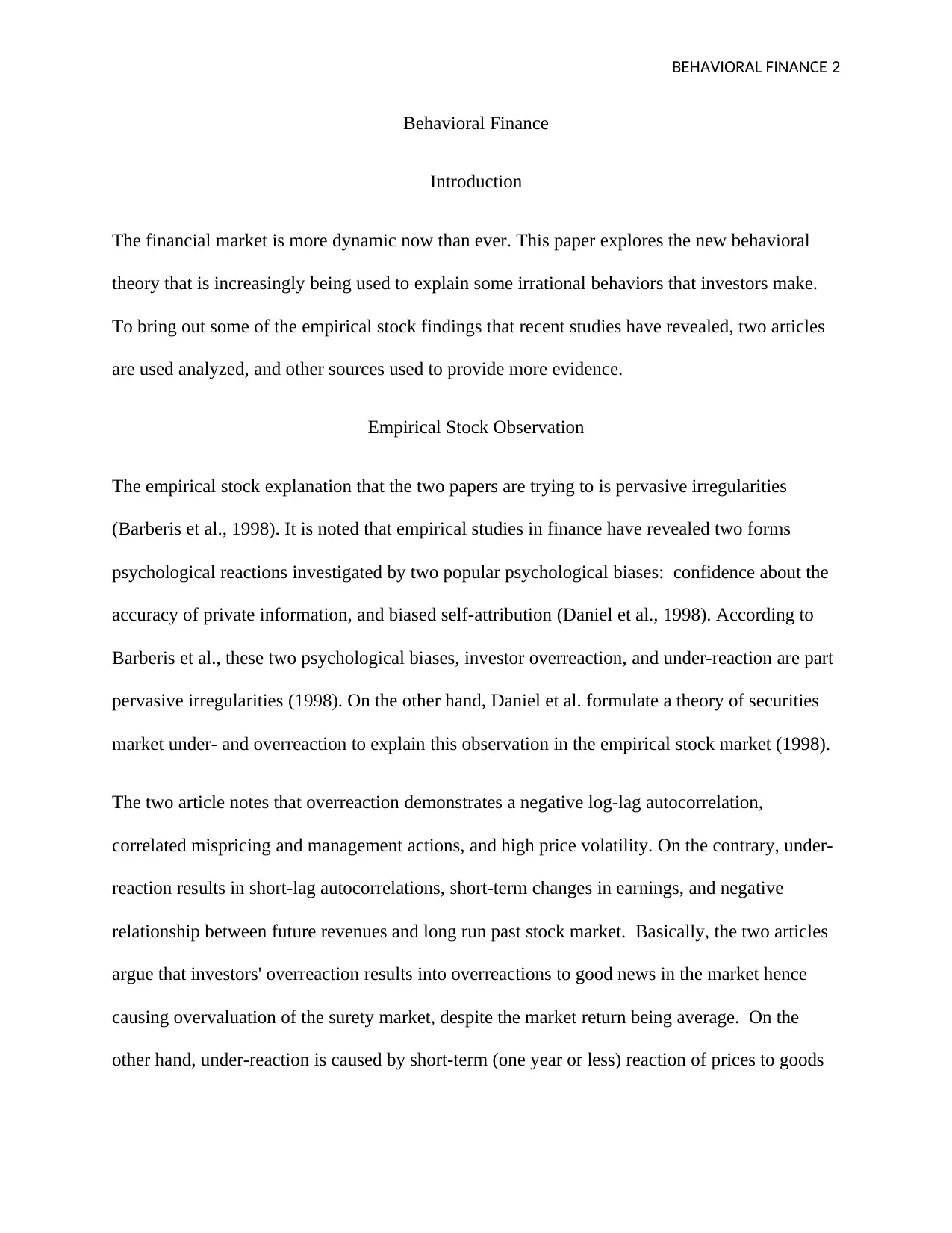
BEHAVIORAL FINANCE 2
Behavioral Finance
Introduction
The financial market is more dynamic now than ever. This paper explores the new behavioral
theory that is increasingly being used to explain some irrational behaviors that investors make.
To bring out some of the empirical stock findings that recent studies have revealed, two articles
are used analyzed, and other sources used to provide more evidence.
Empirical Stock Observation
The empirical stock explanation that the two papers are trying to is pervasive irregularities
(Barberis et al., 1998). It is noted that empirical studies in finance have revealed two forms
psychological reactions investigated by two popular psychological biases: confidence about the
accuracy of private information, and biased self-attribution (Daniel et al., 1998). According to
Barberis et al., these two psychological biases, investor overreaction, and under-reaction are part
pervasive irregularities (1998). On the other hand, Daniel et al. formulate a theory of securities
market under- and overreaction to explain this observation in the empirical stock market (1998).
The two article notes that overreaction demonstrates a negative log-lag autocorrelation,
correlated mispricing and management actions, and high price volatility. On the contrary, under-
reaction results in short-lag autocorrelations, short-term changes in earnings, and negative
relationship between future revenues and long run past stock market. Basically, the two articles
argue that investors' overreaction results into overreactions to good news in the market hence
causing overvaluation of the surety market, despite the market return being average. On the
other hand, under-reaction is caused by short-term (one year or less) reaction of prices to goods
Behavioral Finance
Introduction
The financial market is more dynamic now than ever. This paper explores the new behavioral
theory that is increasingly being used to explain some irrational behaviors that investors make.
To bring out some of the empirical stock findings that recent studies have revealed, two articles
are used analyzed, and other sources used to provide more evidence.
Empirical Stock Observation
The empirical stock explanation that the two papers are trying to is pervasive irregularities
(Barberis et al., 1998). It is noted that empirical studies in finance have revealed two forms
psychological reactions investigated by two popular psychological biases: confidence about the
accuracy of private information, and biased self-attribution (Daniel et al., 1998). According to
Barberis et al., these two psychological biases, investor overreaction, and under-reaction are part
pervasive irregularities (1998). On the other hand, Daniel et al. formulate a theory of securities
market under- and overreaction to explain this observation in the empirical stock market (1998).
The two article notes that overreaction demonstrates a negative log-lag autocorrelation,
correlated mispricing and management actions, and high price volatility. On the contrary, under-
reaction results in short-lag autocorrelations, short-term changes in earnings, and negative
relationship between future revenues and long run past stock market. Basically, the two articles
argue that investors' overreaction results into overreactions to good news in the market hence
causing overvaluation of the surety market, despite the market return being average. On the
other hand, under-reaction is caused by short-term (one year or less) reaction of prices to goods

BEHAVIORAL FINANCE 3
news hence assuming a higher average return on the firm’s securities after the announcement of
preferable news.
Importance of Behavioral Explanation
For a long time, traditional finance has been used to explain actions taken by investors in the
market (Chaudhary, 2013). However, efficiency in the market cannot be achieved. With the
ever-changing economic cases, investment in various firms is increasingly becoming a
complicated decision to make. A significant number of investors have rational projections and
want to derive maximum utility from the investments they make (Yuen, 2017). On the contrary,
in the short run, people are not always rational and may not tend to maximize profits.
Consequently, the insufficiency of the traditional financial theories necessitates behavioral
explanations.
Generally, human beings are subject to several behavioral inconsistencies which, sometimes,
proves counterproductive to the optimization of profits principles hence resulting in irrational
tendencies (Chaudhary, 2013). Accordingly, behavioral finance interlinks behavioral and
cognitive psychological theories with traditional financial concepts to explain the reason behind
some irrational financial decisions. The explanation is more applicable in the stock and securities
market than other investment avenues (Nour et al., 2017). Besides, the portfolio theory has a
number of gaps that are demonstrated by human behavior.
People are more convinced by the information they have on their minds. Additionally, the beliefs
they hold on currently have a significant impact on every decision that they make in the course
of investment. Admittedly, there is a high probability that any information, no matter how
irrational it is, that agrees with their belief system stands a high chance of grabbing their
news hence assuming a higher average return on the firm’s securities after the announcement of
preferable news.
Importance of Behavioral Explanation
For a long time, traditional finance has been used to explain actions taken by investors in the
market (Chaudhary, 2013). However, efficiency in the market cannot be achieved. With the
ever-changing economic cases, investment in various firms is increasingly becoming a
complicated decision to make. A significant number of investors have rational projections and
want to derive maximum utility from the investments they make (Yuen, 2017). On the contrary,
in the short run, people are not always rational and may not tend to maximize profits.
Consequently, the insufficiency of the traditional financial theories necessitates behavioral
explanations.
Generally, human beings are subject to several behavioral inconsistencies which, sometimes,
proves counterproductive to the optimization of profits principles hence resulting in irrational
tendencies (Chaudhary, 2013). Accordingly, behavioral finance interlinks behavioral and
cognitive psychological theories with traditional financial concepts to explain the reason behind
some irrational financial decisions. The explanation is more applicable in the stock and securities
market than other investment avenues (Nour et al., 2017). Besides, the portfolio theory has a
number of gaps that are demonstrated by human behavior.
People are more convinced by the information they have on their minds. Additionally, the beliefs
they hold on currently have a significant impact on every decision that they make in the course
of investment. Admittedly, there is a high probability that any information, no matter how
irrational it is, that agrees with their belief system stands a high chance of grabbing their
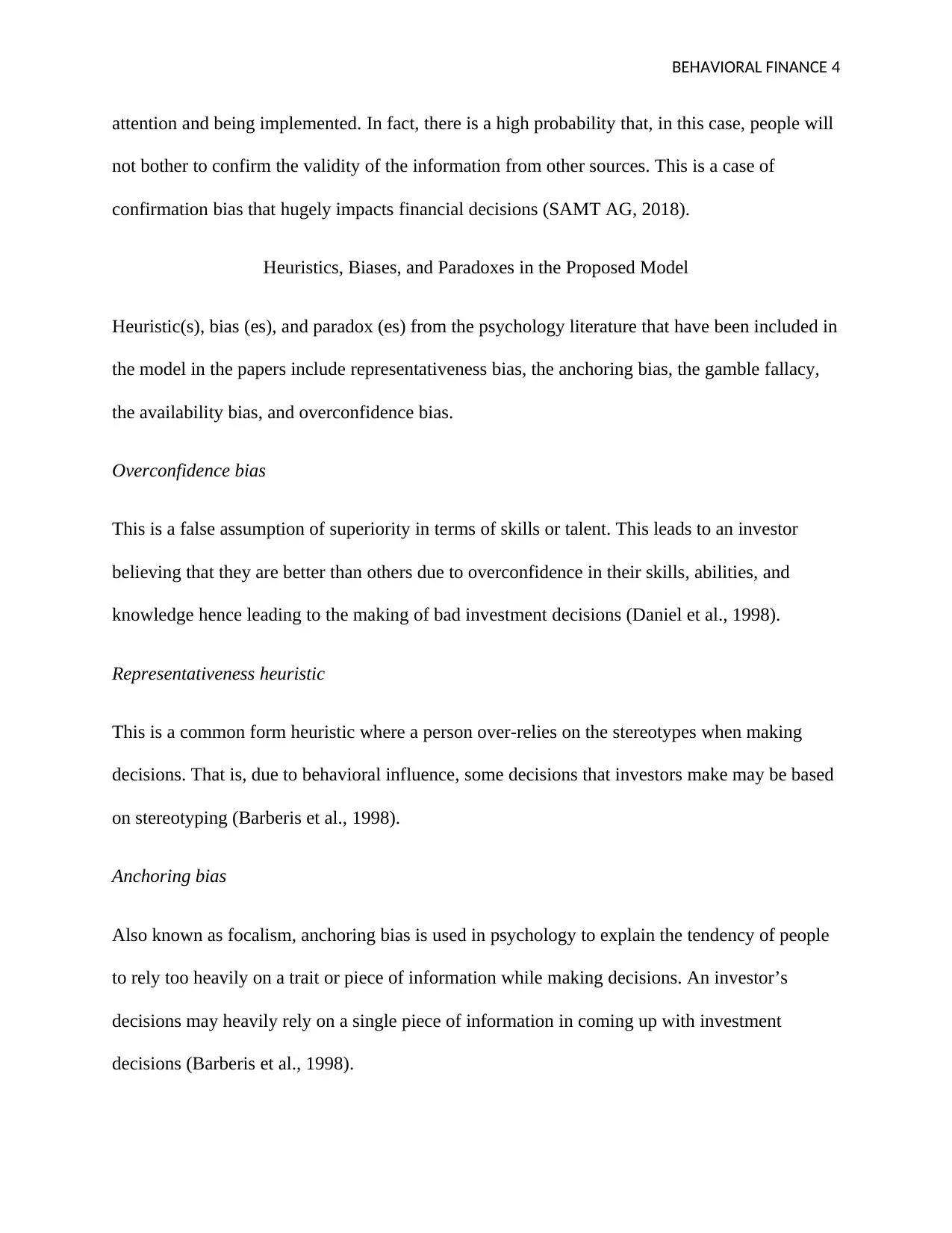
BEHAVIORAL FINANCE 4
attention and being implemented. In fact, there is a high probability that, in this case, people will
not bother to confirm the validity of the information from other sources. This is a case of
confirmation bias that hugely impacts financial decisions (SAMT AG, 2018).
Heuristics, Biases, and Paradoxes in the Proposed Model
Heuristic(s), bias (es), and paradox (es) from the psychology literature that have been included in
the model in the papers include representativeness bias, the anchoring bias, the gamble fallacy,
the availability bias, and overconfidence bias.
Overconfidence bias
This is a false assumption of superiority in terms of skills or talent. This leads to an investor
believing that they are better than others due to overconfidence in their skills, abilities, and
knowledge hence leading to the making of bad investment decisions (Daniel et al., 1998).
Representativeness heuristic
This is a common form heuristic where a person over-relies on the stereotypes when making
decisions. That is, due to behavioral influence, some decisions that investors make may be based
on stereotyping (Barberis et al., 1998).
Anchoring bias
Also known as focalism, anchoring bias is used in psychology to explain the tendency of people
to rely too heavily on a trait or piece of information while making decisions. An investor’s
decisions may heavily rely on a single piece of information in coming up with investment
decisions (Barberis et al., 1998).
attention and being implemented. In fact, there is a high probability that, in this case, people will
not bother to confirm the validity of the information from other sources. This is a case of
confirmation bias that hugely impacts financial decisions (SAMT AG, 2018).
Heuristics, Biases, and Paradoxes in the Proposed Model
Heuristic(s), bias (es), and paradox (es) from the psychology literature that have been included in
the model in the papers include representativeness bias, the anchoring bias, the gamble fallacy,
the availability bias, and overconfidence bias.
Overconfidence bias
This is a false assumption of superiority in terms of skills or talent. This leads to an investor
believing that they are better than others due to overconfidence in their skills, abilities, and
knowledge hence leading to the making of bad investment decisions (Daniel et al., 1998).
Representativeness heuristic
This is a common form heuristic where a person over-relies on the stereotypes when making
decisions. That is, due to behavioral influence, some decisions that investors make may be based
on stereotyping (Barberis et al., 1998).
Anchoring bias
Also known as focalism, anchoring bias is used in psychology to explain the tendency of people
to rely too heavily on a trait or piece of information while making decisions. An investor’s
decisions may heavily rely on a single piece of information in coming up with investment
decisions (Barberis et al., 1998).
Secure Best Marks with AI Grader
Need help grading? Try our AI Grader for instant feedback on your assignments.
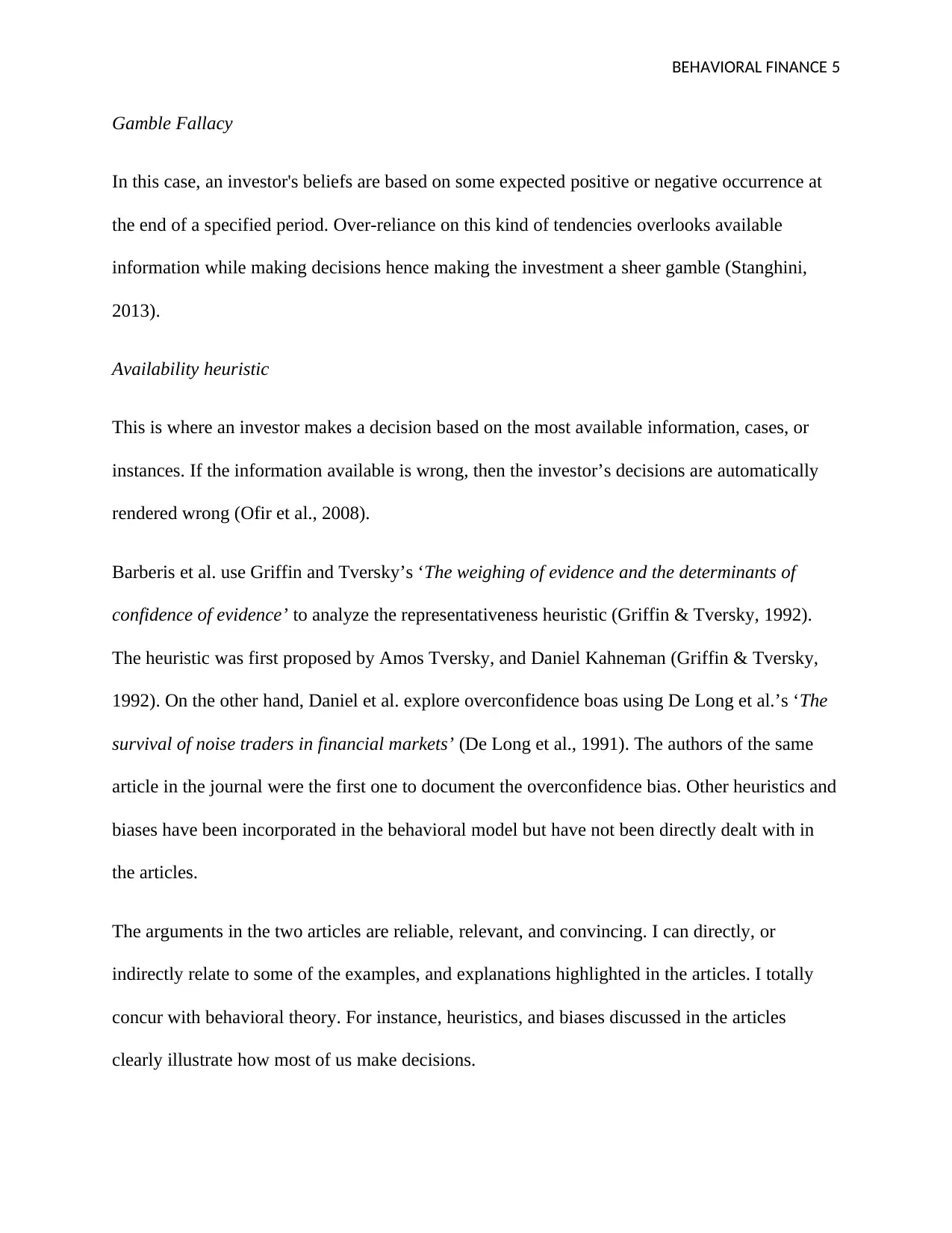
BEHAVIORAL FINANCE 5
Gamble Fallacy
In this case, an investor's beliefs are based on some expected positive or negative occurrence at
the end of a specified period. Over-reliance on this kind of tendencies overlooks available
information while making decisions hence making the investment a sheer gamble (Stanghini,
2013).
Availability heuristic
This is where an investor makes a decision based on the most available information, cases, or
instances. If the information available is wrong, then the investor’s decisions are automatically
rendered wrong (Ofir et al., 2008).
Barberis et al. use Griffin and Tversky’s ‘The weighing of evidence and the determinants of
confidence of evidence’ to analyze the representativeness heuristic (Griffin & Tversky, 1992).
The heuristic was first proposed by Amos Tversky, and Daniel Kahneman (Griffin & Tversky,
1992). On the other hand, Daniel et al. explore overconfidence boas using De Long et al.’s ‘The
survival of noise traders in financial markets’ (De Long et al., 1991). The authors of the same
article in the journal were the first one to document the overconfidence bias. Other heuristics and
biases have been incorporated in the behavioral model but have not been directly dealt with in
the articles.
The arguments in the two articles are reliable, relevant, and convincing. I can directly, or
indirectly relate to some of the examples, and explanations highlighted in the articles. I totally
concur with behavioral theory. For instance, heuristics, and biases discussed in the articles
clearly illustrate how most of us make decisions.
Gamble Fallacy
In this case, an investor's beliefs are based on some expected positive or negative occurrence at
the end of a specified period. Over-reliance on this kind of tendencies overlooks available
information while making decisions hence making the investment a sheer gamble (Stanghini,
2013).
Availability heuristic
This is where an investor makes a decision based on the most available information, cases, or
instances. If the information available is wrong, then the investor’s decisions are automatically
rendered wrong (Ofir et al., 2008).
Barberis et al. use Griffin and Tversky’s ‘The weighing of evidence and the determinants of
confidence of evidence’ to analyze the representativeness heuristic (Griffin & Tversky, 1992).
The heuristic was first proposed by Amos Tversky, and Daniel Kahneman (Griffin & Tversky,
1992). On the other hand, Daniel et al. explore overconfidence boas using De Long et al.’s ‘The
survival of noise traders in financial markets’ (De Long et al., 1991). The authors of the same
article in the journal were the first one to document the overconfidence bias. Other heuristics and
biases have been incorporated in the behavioral model but have not been directly dealt with in
the articles.
The arguments in the two articles are reliable, relevant, and convincing. I can directly, or
indirectly relate to some of the examples, and explanations highlighted in the articles. I totally
concur with behavioral theory. For instance, heuristics, and biases discussed in the articles
clearly illustrate how most of us make decisions.
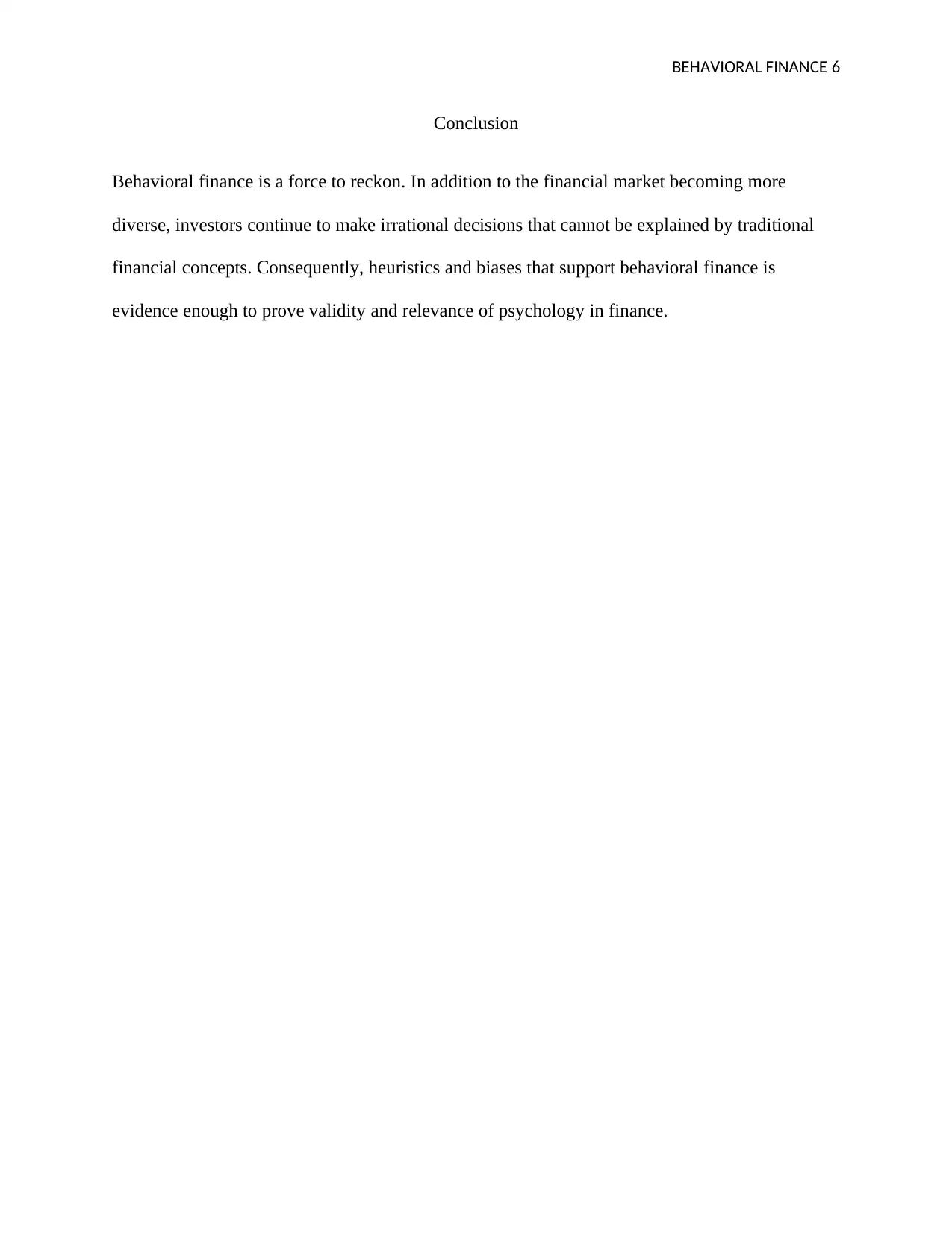
BEHAVIORAL FINANCE 6
Conclusion
Behavioral finance is a force to reckon. In addition to the financial market becoming more
diverse, investors continue to make irrational decisions that cannot be explained by traditional
financial concepts. Consequently, heuristics and biases that support behavioral finance is
evidence enough to prove validity and relevance of psychology in finance.
Conclusion
Behavioral finance is a force to reckon. In addition to the financial market becoming more
diverse, investors continue to make irrational decisions that cannot be explained by traditional
financial concepts. Consequently, heuristics and biases that support behavioral finance is
evidence enough to prove validity and relevance of psychology in finance.
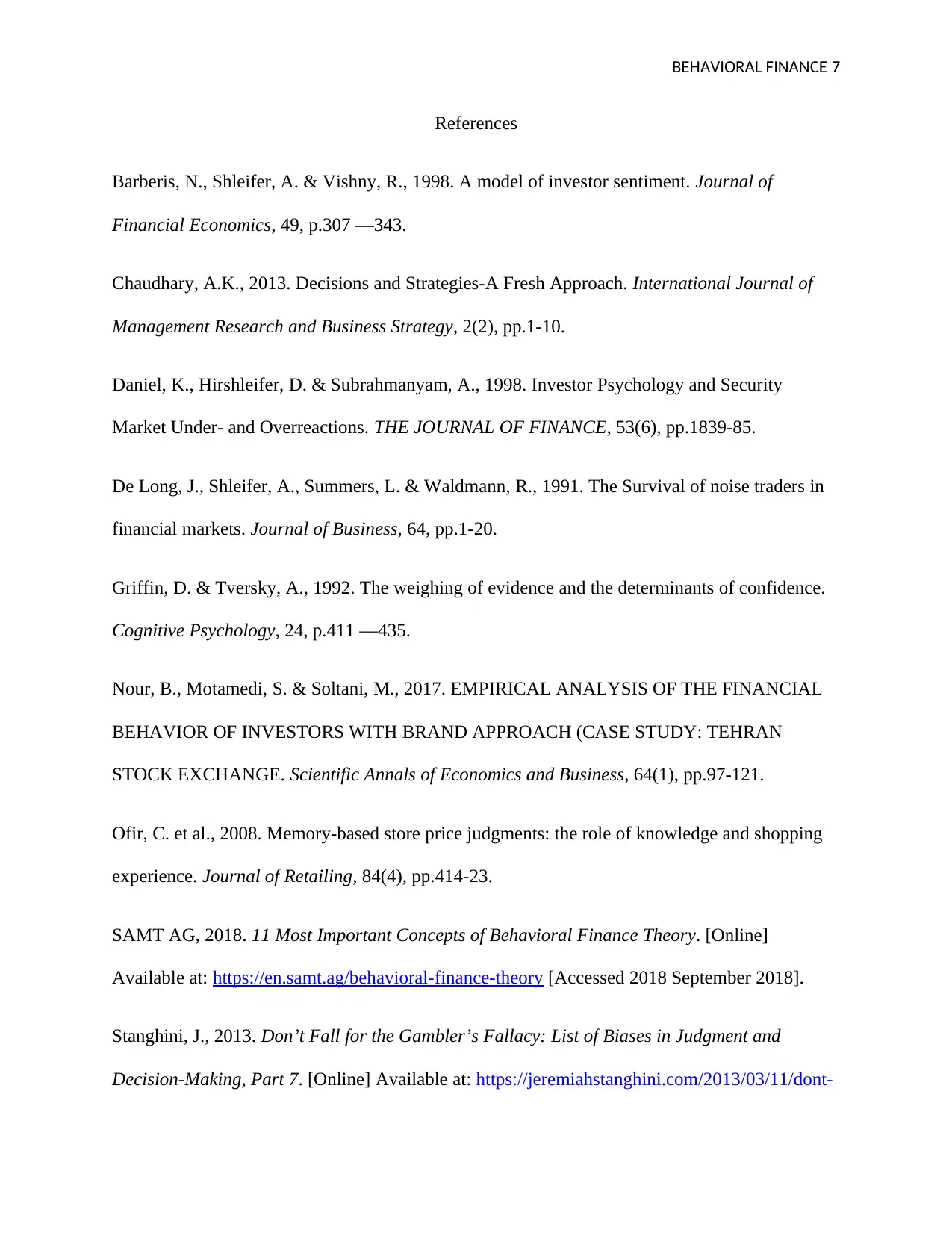
BEHAVIORAL FINANCE 7
References
Barberis, N., Shleifer, A. & Vishny, R., 1998. A model of investor sentiment. Journal of
Financial Economics, 49, p.307 —343.
Chaudhary, A.K., 2013. Decisions and Strategies-A Fresh Approach. International Journal of
Management Research and Business Strategy, 2(2), pp.1-10.
Daniel, K., Hirshleifer, D. & Subrahmanyam, A., 1998. Investor Psychology and Security
Market Under- and Overreactions. THE JOURNAL OF FINANCE, 53(6), pp.1839-85.
De Long, J., Shleifer, A., Summers, L. & Waldmann, R., 1991. The Survival of noise traders in
financial markets. Journal of Business, 64, pp.1-20.
Griffin, D. & Tversky, A., 1992. The weighing of evidence and the determinants of confidence.
Cognitive Psychology, 24, p.411 —435.
Nour, B., Motamedi, S. & Soltani, M., 2017. EMPIRICAL ANALYSIS OF THE FINANCIAL
BEHAVIOR OF INVESTORS WITH BRAND APPROACH (CASE STUDY: TEHRAN
STOCK EXCHANGE. Scientific Annals of Economics and Business, 64(1), pp.97-121.
Ofir, C. et al., 2008. Memory-based store price judgments: the role of knowledge and shopping
experience. Journal of Retailing, 84(4), pp.414-23.
SAMT AG, 2018. 11 Most Important Concepts of Behavioral Finance Theory. [Online]
Available at: https://en.samt.ag/behavioral-finance-theory [Accessed 2018 September 2018].
Stanghini, J., 2013. Don’t Fall for the Gambler’s Fallacy: List of Biases in Judgment and
Decision-Making, Part 7. [Online] Available at: https://jeremiahstanghini.com/2013/03/11/dont-
References
Barberis, N., Shleifer, A. & Vishny, R., 1998. A model of investor sentiment. Journal of
Financial Economics, 49, p.307 —343.
Chaudhary, A.K., 2013. Decisions and Strategies-A Fresh Approach. International Journal of
Management Research and Business Strategy, 2(2), pp.1-10.
Daniel, K., Hirshleifer, D. & Subrahmanyam, A., 1998. Investor Psychology and Security
Market Under- and Overreactions. THE JOURNAL OF FINANCE, 53(6), pp.1839-85.
De Long, J., Shleifer, A., Summers, L. & Waldmann, R., 1991. The Survival of noise traders in
financial markets. Journal of Business, 64, pp.1-20.
Griffin, D. & Tversky, A., 1992. The weighing of evidence and the determinants of confidence.
Cognitive Psychology, 24, p.411 —435.
Nour, B., Motamedi, S. & Soltani, M., 2017. EMPIRICAL ANALYSIS OF THE FINANCIAL
BEHAVIOR OF INVESTORS WITH BRAND APPROACH (CASE STUDY: TEHRAN
STOCK EXCHANGE. Scientific Annals of Economics and Business, 64(1), pp.97-121.
Ofir, C. et al., 2008. Memory-based store price judgments: the role of knowledge and shopping
experience. Journal of Retailing, 84(4), pp.414-23.
SAMT AG, 2018. 11 Most Important Concepts of Behavioral Finance Theory. [Online]
Available at: https://en.samt.ag/behavioral-finance-theory [Accessed 2018 September 2018].
Stanghini, J., 2013. Don’t Fall for the Gambler’s Fallacy: List of Biases in Judgment and
Decision-Making, Part 7. [Online] Available at: https://jeremiahstanghini.com/2013/03/11/dont-
Paraphrase This Document
Need a fresh take? Get an instant paraphrase of this document with our AI Paraphraser
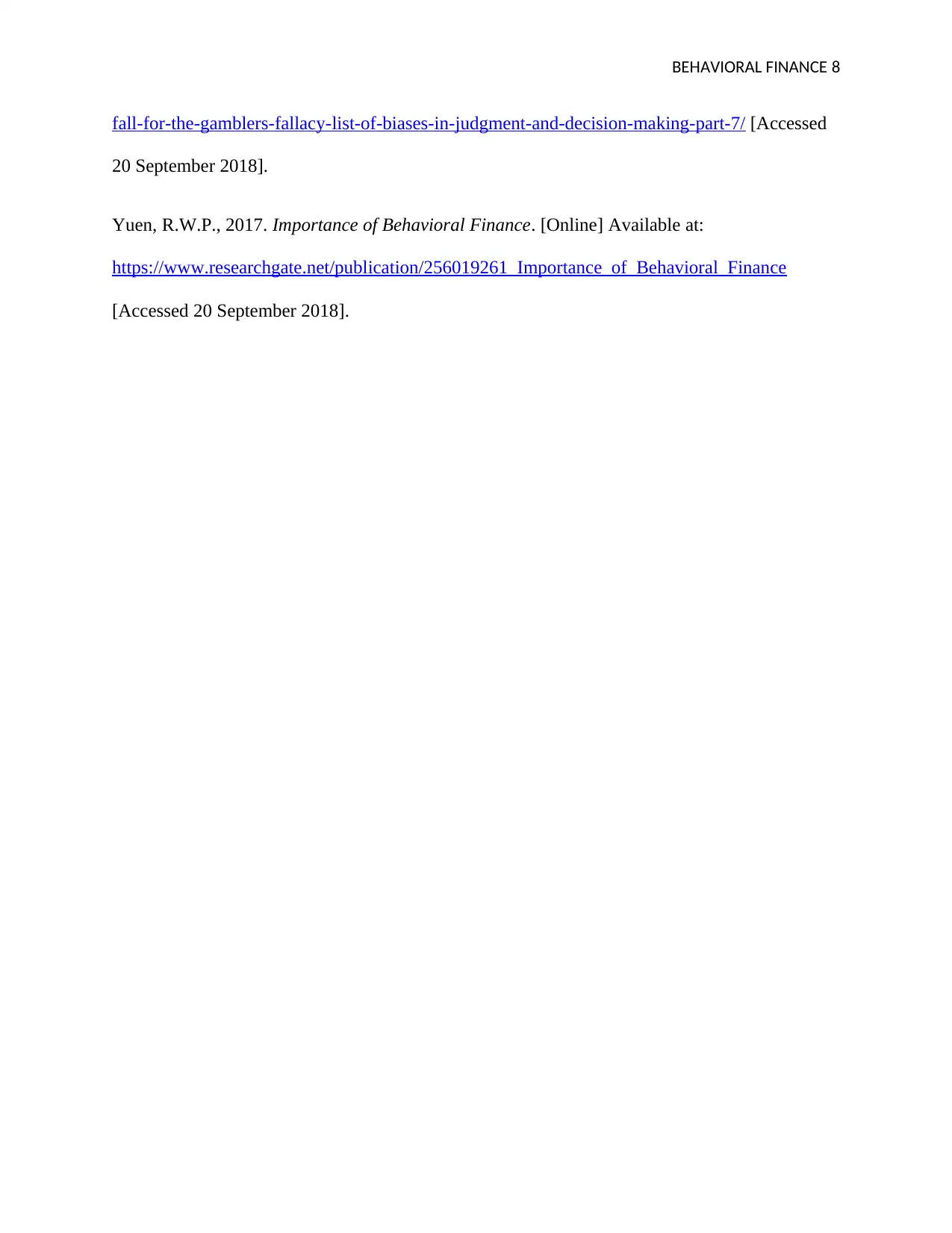
BEHAVIORAL FINANCE 8
fall-for-the-gamblers-fallacy-list-of-biases-in-judgment-and-decision-making-part-7/ [Accessed
20 September 2018].
Yuen, R.W.P., 2017. Importance of Behavioral Finance. [Online] Available at:
https://www.researchgate.net/publication/256019261_Importance_of_Behavioral_Finance
[Accessed 20 September 2018].
fall-for-the-gamblers-fallacy-list-of-biases-in-judgment-and-decision-making-part-7/ [Accessed
20 September 2018].
Yuen, R.W.P., 2017. Importance of Behavioral Finance. [Online] Available at:
https://www.researchgate.net/publication/256019261_Importance_of_Behavioral_Finance
[Accessed 20 September 2018].
1 out of 8
Your All-in-One AI-Powered Toolkit for Academic Success.
+13062052269
info@desklib.com
Available 24*7 on WhatsApp / Email
![[object Object]](/_next/static/media/star-bottom.7253800d.svg)
Unlock your academic potential
© 2024 | Zucol Services PVT LTD | All rights reserved.
